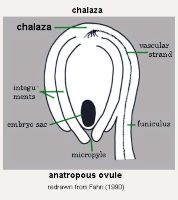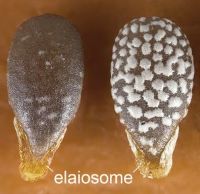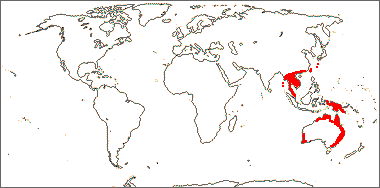Family name: Philydraceae Link
Synonym(s): [none]
Common name(s): philydrum family
*Number of genera/species: 3/6
List of genera records in GRIN-Global
fruit or seed
Fruit a 3-valved loculicidalloculicidal:
type of capsular dehiscence, opening longitudinally through the locules (compare septicidal)
 capsulecapsule:
capsulecapsule:
a dry, dehiscent fruit derived from a compound ovary , sometimes a septicidalsepticidal:
, sometimes a septicidalsepticidal:
type of capsular dehiscence, opening longitudinally by separating between the septa of adjacent carpels
 capsulecapsule:
capsulecapsule:
a dry, dehiscent fruit derived from a compound ovary or berryberry:
or berryberry:
an indehiscent, fleshy fruit with one or a few to many seeds. The flesh may be homogenous throughout. Or, if the outer part is hard, firm, or leathery, referred to as an hesperidium. Septa are present in some, and the seeds may be arillate or with a fleshy testa. (Helmholtzia), 3–10 mm long, globoseglobose:
(Helmholtzia), 3–10 mm long, globoseglobose:
3D shape—more or less spherical to fusiformfusiform:
to fusiformfusiform:
spindle-shaped; broadest at the middle and tapering at both ends , tereteterete:
, tereteterete:
approximately circular in cross section; width and thickness approximately equal
 in transection, with many seeds. Pericarppericarp:
in transection, with many seeds. Pericarppericarp:
fruit wall or fruit coat
white, blue, or brown, smooth, sometimes pubescentpubescent:
surface relief—bearing hairs
.
Seeds linearlinear:
(shape) long, narrow, and uniform in width; (of embryo) embryo is straight and much longer than wide to teardrop-shapedteardrop-shaped:
to teardrop-shapedteardrop-shaped:
2D shape—widest point is toward one end of the fruit, the other end tapers sharply to a pointed end , tereteterete:
, tereteterete:
approximately circular in cross section; width and thickness approximately equal
 in transection, less than 1 mm (Philydrum, Philydrella) to 1.5–5 mm long (Helmholtzia), usually with red-colored chalazalchalaza:
in transection, less than 1 mm (Philydrum, Philydrella) to 1.5–5 mm long (Helmholtzia), usually with red-colored chalazalchalaza:
the region at the base of the ovule where the integuments are inserted cap and an operculumoperculum:
cap and an operculumoperculum:
a dehiscent cap (or lid) of a seed or fruit that opens during germination or dehiscence . Seed coat red, yellow, or brown, reticulate-rugose (Philydrella), spirally striate-tuberculate (Philydrum), or silky-striate (Helmholtzia). In one species of Helmholtzia, chalazalchalaza:
. Seed coat red, yellow, or brown, reticulate-rugose (Philydrella), spirally striate-tuberculate (Philydrum), or silky-striate (Helmholtzia). In one species of Helmholtzia, chalazalchalaza:
the region at the base of the ovule where the integuments are inserted is twisted and appears like an elaiosomeelaiosome:
is twisted and appears like an elaiosomeelaiosome:
a lipid and protein-rich fleshy structure attached to some seeds and fruits, it attracts ants which then disperse the disseminule (e.g., caruncle in the Euphorbiaceae, the aril (outgrowth of the funiculus) in the Fabaceae) .
.
Embryo linearlinear:
(shape) long, narrow, and uniform in width; (of embryo) embryo is straight and much longer than wide , straight, axileaxile:
, straight, axileaxile:
on or of the axis
and centric, embedded in endosperm.
Endosperm copious, non-mealy.
| Fruit | |
| Type | capsulecapsule: a dry, dehiscent fruit derived from a compound ovary  , berryberry: , berryberry:an indehiscent, fleshy fruit with one or a few to many seeds. The flesh may be homogenous throughout. Or, if the outer part is hard, firm, or leathery, referred to as an hesperidium. Septa are present in some, and the seeds may be arillate or with a fleshy testa.  |
| Size range | 3–10 mm long |
| Shape(s) | ovoidovoid: 3D shape—ovate  , globoseglobose: , globoseglobose:3D shape—more or less spherical  , fusiformfusiform: , fusiformfusiform:spindle-shaped; broadest at the middle and tapering at both ends  , oblongoblong: , oblongoblong:2D shape—much longer than broad with nearly parallel sides, corners are rounded  , ellipsoidellipsoid: , ellipsoidellipsoid:3D shape—elliptic |
| Texture | fleshy or dry |
| Surface relief | smooth, sometimes pubescentpubescent: surface relief—bearing hairs |
| Color(s) | white, blue, brown |
| Unique features | Small, brown, 3-valved capsulescapsule: a dry, dehiscent fruit derived from a compound ovary  , opening on plant, releasing small and numerous seeds. Or, small, white or blue, fleshy, many-seeded berriesberry: , opening on plant, releasing small and numerous seeds. Or, small, white or blue, fleshy, many-seeded berriesberry:an indehiscent, fleshy fruit with one or a few to many seeds. The flesh may be homogenous throughout. Or, if the outer part is hard, firm, or leathery, referred to as an hesperidium. Septa are present in some, and the seeds may be arillate or with a fleshy testa.  . . |
| Seed | |
| Size range | less than 1 mm or 1.5–5 mm long |
| Shape(s) | ovoidovoid: 3D shape—ovate  , teardrop-shapedteardrop-shaped: , teardrop-shapedteardrop-shaped:2D shape—widest point is toward one end of the fruit, the other end tapers sharply to a pointed end  , ellipsoidellipsoid: , ellipsoidellipsoid:3D shape—elliptic , linearlinear: (shape) long, narrow, and uniform in width; (of embryo) embryo is straight and much longer than wide  , cylindricalcylindrical: , cylindricalcylindrical:3D shape—a cylinder, with parallel sides and a circular cross-section; tubular or rod-shaped , oblongoblong: 2D shape—much longer than broad with nearly parallel sides, corners are rounded  |
| Surface relief | striatestriate: surface relief—having fine, parallel lines, grooves or ridges  , reticulatereticulate: , reticulatereticulate:surface relief—netted, raised walls or concave grooves forming a net-like surface pattern with flat, concave, or convex interspaces  , wrinkledwrinkled: , wrinkledwrinkled:surface relief—shallow, irregular folds and furrows covering the surface; appearing overall though crumpled and then spread out  |
| Color(s) | red, brown, yellow |
| Unique features | Minute to small seeds, usually with reddish-brown, striatestriate: surface relief—having fine, parallel lines, grooves or ridges  or reticulatereticulate: or reticulatereticulate:surface relief—netted, raised walls or concave grooves forming a net-like surface pattern with flat, concave, or convex interspaces  seed coats and red-colored chalazalchalaza: seed coats and red-colored chalazalchalaza:the region at the base of the ovule where the integuments are inserted  caps and operculaoperculum: caps and operculaoperculum:a dehiscent cap (or lid) of a seed or fruit that opens during germination or dehiscence  . . |
| Other | |
| Embryo | linearlinear: (shape) long, narrow, and uniform in width; (of embryo) embryo is straight and much longer than wide  , straight, axileaxile: , straight, axileaxile:on or of the axis and centric, embedded in endosperm |
| Nutritive tissue | endosperm copious |
Australia to Southeast Asia.

Distribution map courtesy of Angiosperm Phylogeny Website.
Baskin and Baskin 2021Baskin and Baskin 2021:
Baskin C and Baskin J. 2021. Relationship of the lateral embryo (in grasses) to other monocot embryos: A status up-grade. Seed Science Research 31 (3): 199-210. doi:10.1017/S0960258521000209; Dahlgren et al. 1985Dahlgren et al. 1985:
Dahlgren RMT, Clifford HT, and Yeo PF. 1985. The families of the monocotyledons: structure, evolution, and taxonomy. Springer-Verlag, Berlin. 520 pp.; Flora of Australia 2021+Flora of Australia 2021+:
Flora of Australia. Australian Biological Resources Study, Canberra. Accessed January 2021–March 2024. URL: http://www.ausflora.org.au; Kirkbride et al. 2006Kirkbride et al. 2006:
Kirkbride JH, Jr, Gunn CR, and Dallwitz MJ. 2006. Family guide for fruits and seeds, vers. 1.0. Accessed September 2020-January 2022. URL: https://nt.ars-grin.gov/seedsfruits/keys/frsdfam/index.cfm .; Kubitzki et al. 1990+Kubitzki et al. 1990+:
Kubitzki K et al., eds. 1990+. The families and genera of vascular plants. 7+ vols. Berlin etc.; Skottsberg 1948Skottsberg 1948:
Skottsberg C. 1948. Philydraceae. Flora Malesiana Ser.1, Spermatophyta 4 (1): 5-7. https://doi.org/10.5962/bhl.title.40744
*The number of genera and species is based on Christenhusz and Byng 2016Christenhusz and Byng 2016:
Christenhusz MJM and Byng JW. 2016. The number of known plant species in the world and its annual increase. Phytotaxa 261 (3): 201-217. https://doi.org/10.11646/phytotaxa.261.3.1, which may differ from the number of genera in GRIN-Global.